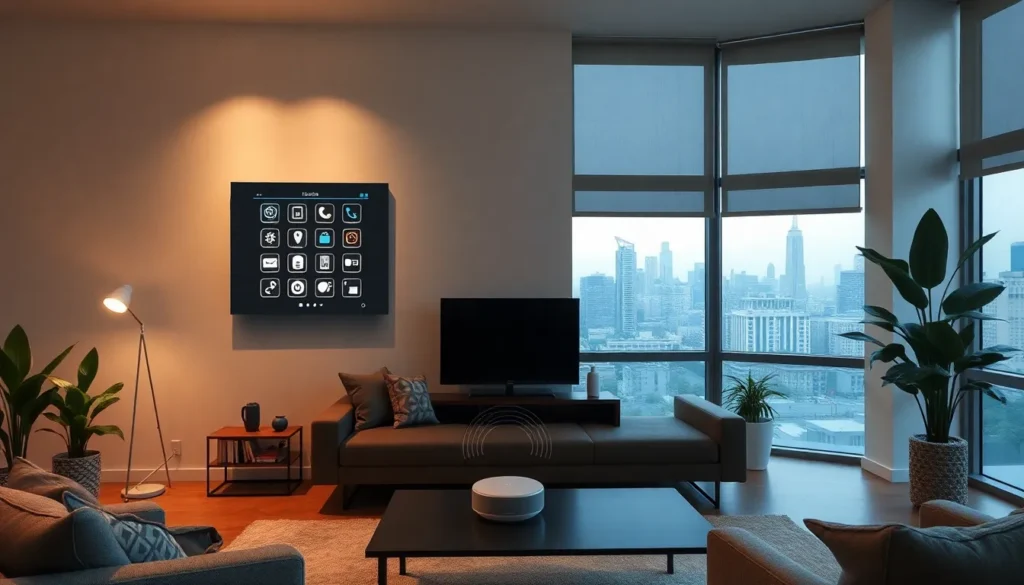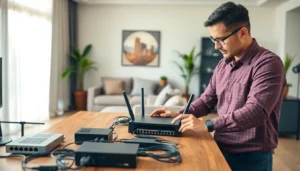Table of Contents
ToggleImagine walking into your home, and with a single voice command, the lights dim, your favorite playlist starts playing, and the thermostat adjusts to the perfect temperature. Welcome to the world of home automation networking. It’s like living in a sci-fi movie, but charmingly less dystopian. In this text, we’ll break down everything you need to know about creating a connected home that works seamlessly, just like your favorite gadget. Let’s immerse and see how you can upgrade your lifestyle, one smart device at a time.
Understanding Home Automation Networking

Home automation networking involves integrating various smart devices within a home to create a cohesive and efficient living environment. This technology enables homeowners to control lighting, heating, doors, and even appliances from their smartphones or via voice commands. The backbone of this convenience is a reliable network that connects all these devices.
To get a better understanding of home automation networking, it’s helpful to consider the underlying principles of IoT, or the Internet of Things. Essentially, IoT connects billions of devices, allowing them to communicate with each other. In a home setting, this means your thermostat can talk to your security camera, or your coffee maker can receive scheduling commands from your smartphone. It’s an interconnected web that turns everyday living into an intelligent experience.
Types of Home Automation Networks
When venturing into home automation networking, it’s important to know about the various types available. Each has its unique advantages and use cases:
- Wi-Fi Networks: These are the most common and are generally easy to set up. Most smart devices connect directly to the home’s Wi-Fi, making them widely compatible. But, traffic can slow down if too many devices are connected.
- Zigbee: A popular choice, Zigbee is known for low power consumption. It creates a mesh network where devices communicate directly with each other, enhancing reliability and range.
- Z-Wave: Similar to Zigbee, Z-Wave focuses on low-energy communication. It typically has a longer range than Zigbee and is compatible with a wide range of devices, making it a favorite among home automation enthusiasts.
- Bluetooth: While commonly used for device pairing, Bluetooth is great for smart home devices that don’t need constant connection. It’s perfect for controlling devices like security cameras or speakers when you’re nearby.
Key Components of Home Automation Networking
To successfully carry out home automation, a few key components are essential:
- Smart Devices: These include your standard gadgets like thermostats, lights, and door locks. They need to be compatible with your chosen network for everything to work seamlessly.
- Hub or Controller: This is the central point of control for all devices. Hubs can unify various protocols like Zigbee and Z-Wave, displaying all devices on one app.
- User Interface: The interface enables users to control devices. This can be through smartphone apps, voice assistants, or even wall-mounted control panels.
- Cloud Services: Many smart devices rely on cloud computing for data processing and remote control. This is where your commands go when you’re practicing your best “Alexa, turn on the lights.” skills.
Choosing the Right Networking Technology
Choosing the best networking technology for home automation is crucial in ensuring everything runs smoothly. Consider these factors:
- Device Compatibility: Ensure that your smart devices can communicate with the network you choose. If you have a mix of devices, a hub that supports multiple protocols might be your best bet.
- Range and Coverage: For larger homes, a network with a broad range, like Z-Wave, might be more effective. Think about the layout of your home and any areas where signal interference could occur.
- Scalability: Your network should adapt as your needs grow. Choose a technology that allows adding new devices easily without significant upgrades.
- Power Consumption: If you’re environmentally conscious, opt for technologies that consume less power, such as Zigbee or Z-Wave.
Security Concerns in Home Automation Networking
As with any networked system, security in home automation networking cannot be overlooked. Here are some tips to keep your smart home safe:
- Strong Passwords: Always change default passwords and use complex combinations of letters, numbers, and symbols. Easy assumptions might just lead to trouble.
- Regular Updates: Ensure all devices and hubs receive regular firmware updates to patch any security vulnerabilities.
- Network Segmentation: Consider creating a separate Wi-Fi network for your smart devices. This limits potential threats to your main device network.
- Two-Factor Authentication: Enable two-factor authentication wherever possible, adding an extra layer of security to your accounts.
Future Trends in Home Automation Networking
The future of home automation networking is bright and developing rapidly. Here are some trends shaping the industry:
- Integration of AI: Artificial intelligence is becoming increasingly pivotal. Algorithms will learn from user behaviors, allowing homes to adapt to users’ preferences automatically.
- Interoperability: The industry is moving toward greater standardization. New technologies are likely to emerge that enable devices from different manufacturers to work together seamlessly.
- Enhanced Security Features: As cyber threats evolve, expect advanced security measures tailored for smart home networks.
- Sustainability Focus: Energy-efficient devices and eco-friendly practices are gaining traction, as consumers become more conscious of their environmental footprint.




